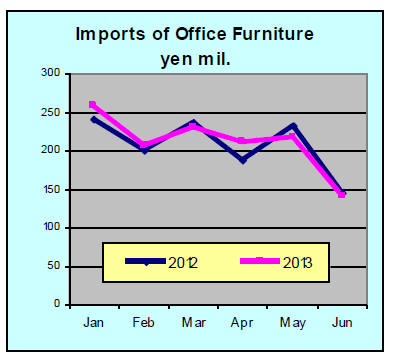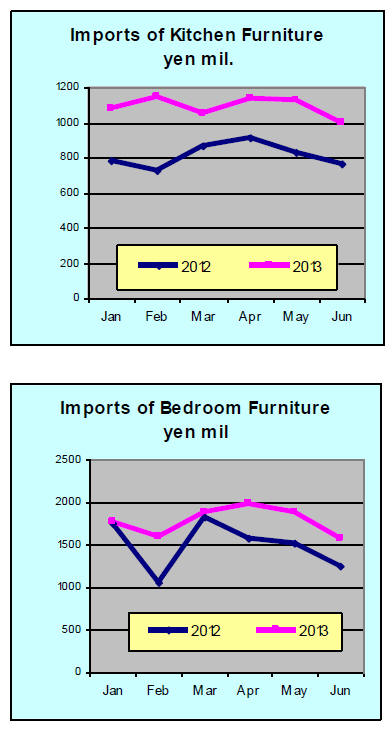Japan
Wood Products Prices
Dollar Exchange Rates
of
26th September 2013
Japan Yen 98.44
Reports From Japan
Be prepared for zero growth in 2014
The Chief Economist at the Japan Center for Economic
Research (JCER), Nobuyasu Atago is warning of a likely
slow down in Japan‟s growth in 2014. For his presentation
see:
http://www.JCER.or.jp/eng/pdf/sa155-eng2.pdf
The JCER economist says in a press release that GDP
grew by an annualized rate of 2.6% during the April–June
period, continuing positive growth from the previous
quarter.
This suggests that the Japanese economy is recovering
well, but these figures do not fully reflect the effects of the
supplementary budget for fiscal 2012 (April 2012 to
March 2013) or the last-minute demand in housing
construction prompted by the impending consumption tax
hike in April next year.
Although these factors will continue to push up growth in
the July–September quarter and beyond, what happens
after the consumption tax rate increases in fiscal 2014
remains to be seen.
JCER is forecasting that the Japanese economy will
continue to expand at an annual rate of over 3% in the
immediate term, and will achieve 2.7% growth in fiscal
2013, owing to recovering external demand, the boost
received from the fiscal 2012 supplementary budget and
last-minute demand before the consumption tax increase
scheduled for April next year.
However, JCER says “it expects growth to slow to around
0.2% in fiscal 2014 as the rebound from factors the
supplementary budget and last minute purchases by
consumers slows resulting in almost zero growth.
The international economy, so crucial for Japanese
exports, is expected to continue its steady recovery. This
recovery will be led by the United States and there are also
indications that the slump in Europe has bottomed out.
In China, on the other hand, there is an increasing risk of
an economic downturn. The Chinese government is
concerned about the risk of a bubble caused by the shadow
banking system and their priority is now to bring an
inflated money supply down.
But it is Japanese domestic demand that will play the most
important role in determining national economic
developments from now on.
The JCER expects an increase and recovery in capital
spending and corporate earnings should improve thanks to
a weaker yen. This will lift profits for listed companies.
There should also be a considerable increase in
consumption and investment in housing as a result of lastminute
demand before the consumption tax rate goes up.
This surge in demand will lift consumption‟s contributions
to real GDP growth for fiscal 2013 by 0.5% and housing
investments by 0.2%. The fiscal 2012 supplementary
budget will also contribute a boost of around 0.6%.
However, a rebound in fiscal 2014 will shrink real growth
by around 1% for consumption and housing investment;
the rebound from the effects of the supplementary budget
will shrink growth by a further 0.3%.
Temporary employment now makes up a large proportion
of the job market, and wage increases are harder to
achieve. These fact ors mean that household budgets are
tight and there is little cash to spare. If real disposable
income or actual net assets shrink as a result of the
consumption tax rate increase or higher prices, there is a
possibility that the negative impact on consumption will
be more severe than anticipated.
In the currency markets, JCER expects the tendency
toward a slightly cheaper yen to continue. Japan will
continue its program of qualitative and quantitative easing,
while in the United States the third round of quantitative
easing (QE3) will be reduced in size in the near future,
perhaps as early as this year. The gap between US and
Japanese interest rates is likely to widen. Based on this,
exports should continue their modest increase.”
Business sentiment in large manufacturers provides
support for consumption tax increase
The Bank of Japan quarterly survey of business sentiment
(Tankan) was released on 1 October and has provided the
government with the confidence to proceed with plans to
raise the consumption tax in Japan.

The key index which is closely watched the that of
sentiment amongst major manufacturers. In the latest
survey this index rose to +12 from plus 4 in the June
survey. This result was much better than economists had
expected and was the third consecutive quarter of
improvement.
The survey showed that large manufacturers were scaling
back investment plans to the surprise of analysts who
attribute the caution on the part of manufacturers to rising
energy costs.
All nuclear reactors in Japan are now shut down meaning
Japan has to import all fuel for power generation at a time
when the yen has weakened thus pushing up the import
bill.
Sentiment amongst small manufacturers remains firmly
pessimistic but some are reading the change in index from
-14 to -9 as a sign of moderating skepticism.
Growing trade deficit with China
The Japan External Trade Organization (JETRO) has
reported that, in US dollar terms, Japan.s trade with China
dropped 10.8% to US$147.3 billion in the first half of
2013, marking the first drop in four years on a first halfyear
basis since 2009.
In the same period imports from China fell by 6.1% to
US$85.8 billion, marking the first drop since 2009.
Japan.s balance of trade was in deficit by over US$24.4
billion, an increase of 1.4 times over the same period last
year setting a new record on a first half-year basis.
Also, Japan.s global first half exports fell 12.6% in US
dollar terms to US$358.1 billion year on year. The decline
in exports to China was the major reason for the overall
drop in exports.
Outlook for the second half 2013
The Chinese government is now emphasising its structural
reform over economic growth and Jetro considers the
Chinese government is unlikely to implement large-scale
stimulus measures to boost domestic demand. Further,
Jetro says China.s slowing industrial production and
consumption are forecast to continue so Japan.s exports to
China are likely to decline.
In spite of the stable demand for smart phones and signs of
recovery in the Japanese economy, imports from China
will likely see only a small improvement because of
weakened price competitiveness in raw materials and
intermediate goods due to the weak yen. Overall, says
Jetro, the Japan-China trade for 2013 is likely to fall for
the second consecutive year.
For the full Jetro report see:
https://www.jetro.go.jp/en/news/releases/20130820558-
news
Trade news from the Japan Lumber Reports (JLR)
The Japan Lumber Reports (JLR), a subscription trade
journal published every two weeks in English, is
generously allowing the ITTO Tropical Timber Market
Report to extract and reproduce news on the Japanese
market.
The JLR requires that ITTO reproduces newsworthy text
exactly as it appears in their publication.
For the JLR report please see:
http://www.nmokuzai.
com/modules/general/index.php?id=7
Plywood supply for the first half of this year
Total supply of plywood of both domestic and import for
the first six months of this year was 3,271,500 cbms, 9.6%
more than the same period of last year. Domestic supply
was 9.6% more and imports were 9.6% more. Monthly
average was 317,900 cbms, 27,900 cbms more than the
average in 2012.
In Malaysia, log supply shortage was serious from the
beginning of the year and the export FOB prices soared
then at the same time, the yen got weaker, which pushed
sales prices in Japan considerably. An anticipation of
future high prices stimulated active speculative purchases.
Monthly average of Malaysian plywood was 147,900
cbms, about 20,000 cbms more than 2012. However, since
last spring, the anticipated demand pickup did not
materialise.
The arrivals for March and April were more than 340 M
cbms, which resulted in more than two weeks waiting for
unloading of cargoes in Japan. This led to reduction of
future purchase. Port inventories are expected to drop in
coming months so that the supply and demand should
balance out.
In domestic supply, softwood plywood production was
1,266,300 cbms, 11.6% more. The monthly average was
211,000 cbms, about 22,000 cbms more than 2012. Also
the shipment was 1,296,500 cbms, 22.2% more than 2012.
Average monthly inventory was 128,200 cbms, which is
about 80 M cbms less than monthly average of 208,400
cbms in 2012.
South Sea (Tropical) logs
In Malaysia, log prices are seesawing between suppliers
and buyers. Log production is recovering after recovery of
weather and vacation season but the demand is active by
purchase of local plywood mills and India so that supply
and demand is balancing.
Some log suppliers are bullish and others are bearish.
Sarawak meranti regular prices are $280-290 per cbm
FOB, unchanged from August. Small meranti prices are
$250 and super small are $220.
They are all flat from August. Sabah kapur regular prices
are firm at $370 due to tight supply of quality logs.
Considering coming rainy season since November,
Japanese buyers wish to have reduced log prices now
while logging season lasts but compared to India, purchase
volume by Japan is too small to take initiative in price
negotiations.
India continues buying necessary volume although they
are reluctant to buy high price logs because of weakening
of their currency rupee. If India strengthens log purchase,
FOB prices would surely go up.
Meanwhile, Japanese plywood mills strongly resist paying
higher log prices.
South Sea hardwood plywood demand in Japan has been
slightly recovering since last month. Log prices in Japan in
late August were about 10,000 yen per koku CIF on
Sarawak meranti regular, 400-500 yen up from early July.
Due to weak yen, future prices would be much higher.
Marked differences in furniture import trends
The following three graphics illustrate the trends in
Japan‟s imports of office, kitchen and bedroom furniture
in the first half of 2012 and 2013.
Overall furniture imports in the first half of 2013 were
higher than in the same period in 2012 but there are
marked differences in the trend for various categories of
furniture.
While 2013 imports of kitchen and bedroom furniture are
significantly higher than in the same period in 2012 the
level of imports of office furniture has not increased.
The low level of office furniture is a reflection of business
activity and investment especially for the small and
medium sized companies. In 2012 many small business
folded and confidence has not returned to this sub sector.
Small companies are not benefiting from the mere
„sentiment‟ that the Japanese economy is improving, they
are finding that sentiment is not translating into significant
new business and as a result are not investing in
manufacturing plant or office furniture
 
In contrast imports of kitchen and bedroom furniture in the
first half of 2013 are well above that in the same period in
2012.
The driving force behind the growth in kitchen and
bedroom furniture has been the expansion in housing
starts, pre-consumption tax hike purchases and purchases
that were put on hold particularly after the devastating
earthquake and tsunami.
|